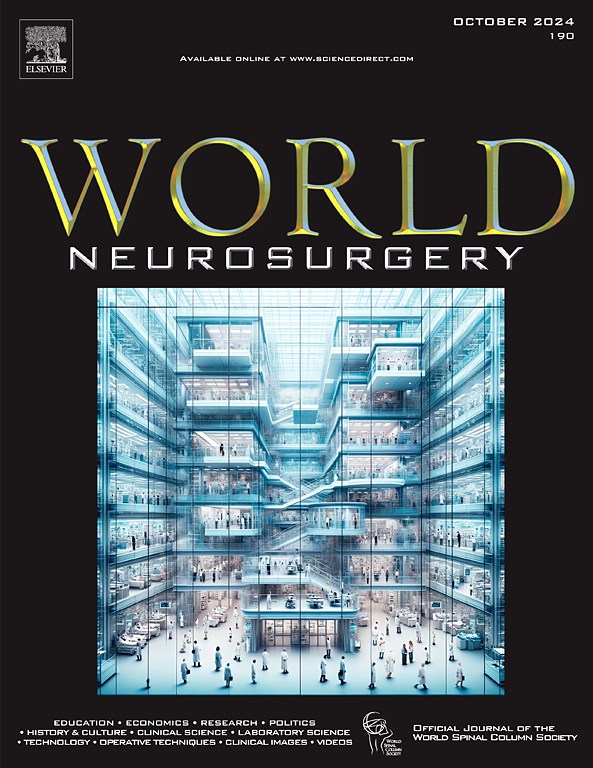Most Roads Lead to Cushing: Mapping Neurosurgical Training Lineages in the United States
IF 2.1
4区 医学
Q3 CLINICAL NEUROLOGY
引用次数: 0
Abstract
Objective
Mentorship and training relationships shape the careers and influence of neurosurgeons. Network analysis can reveal structural characteristics and key individuals who support network connectivity and drive the field's development. This endeavor analyzed the U.S.-based neurosurgical training network derived from NeurosurGen.com.
Methods
A network graph was constructed representing neurosurgical training relationships, including chairperson–trainee, program director–trainee, and coresident connections. Graph- and node-level metrics, with a focus on centrality measures, were calculated for a trainer–trainee subgraph.
Results
The network consisted of 8840 neurosurgeons represented as nodes, and 382,143 relationships represented as edges. It evolved from an early small-world structure to a hierarchical and decentralized structure dominated by local clusters. Demographic shifts over time reflected increasing diversity and inclusion, with greater representation of female, Hispanic, Asian, and Black trainees across 285 training programs. Nodes were preferentially connected via residency, and the connectivity among underrepresented populations improved in concert with increased representation. Harvey W. Cushing was the quintessential neurosurgeon-influencer in the United States, ranking highly across most centrality measures over time.
Conclusions
The neurosurgical training network is sparse but interconnected, typical of large real-world professional networks. While many small groups of neurosurgeons are closely tied within their immediate training hierarchy and peer group, in modern neurosurgery, each surgeon is only connected to a small fraction of the total network. Highly central individuals have played critical roles in linking disparate groups and shaping network structure. Increasing diversity in recent decades indicates progress toward inclusivity, although overall representation remains low.
多数道路通向库欣:绘制美国神经外科训练谱系。
目的:师徒关系和培训关系对神经外科医生职业生涯的影响。网络分析可以揭示网络连接的结构特征和支持网络连接并推动该领域发展的关键人物。方法:构建神经外科培训关系的网络图,包括主席-学员、项目主任-学员和联合住院医师的关系。图级和节点级度量,重点是中心性度量,为训练者-受训者子图计算。结果:该网络由8840个神经外科医生组成,以节点表示,382143个关系以边表示。它从早期的小世界结构演变为由地方集群主导的分层和分散结构。随着时间的推移,人口结构的变化反映出越来越多的多样性和包容性,在285个培训项目中,女性、西班牙裔、亚裔和黑人学员的比例更高。节点优先通过居住地连接,代表性不足的人口之间的连通性随着代表性的增加而改善。哈维·库欣(Harvey Cushing)是美国典型的神经外科影响者,随着时间的推移,他在大多数中心性指标中排名很高。结论:神经外科训练网络稀疏但相互联系,具有现实世界大型专业网络的典型特征。虽然许多神经外科医生的小团体在他们的直接培训等级和同伴群体中紧密联系在一起,但在现代神经外科中,每个外科医生只与整个网络的一小部分相连。高度中心的个体在连接不同群体和形成网络结构方面发挥了关键作用。近几十年来,多样性的增加表明了包容性的进步,尽管总体代表性仍然很低。
本文章由计算机程序翻译,如有差异,请以英文原文为准。
求助全文
约1分钟内获得全文
求助全文
来源期刊

World neurosurgery
CLINICAL NEUROLOGY-SURGERY
CiteScore
3.90
自引率
15.00%
发文量
1765
审稿时长
47 days
期刊介绍:
World Neurosurgery has an open access mirror journal World Neurosurgery: X, sharing the same aims and scope, editorial team, submission system and rigorous peer review.
The journal''s mission is to:
-To provide a first-class international forum and a 2-way conduit for dialogue that is relevant to neurosurgeons and providers who care for neurosurgery patients. The categories of the exchanged information include clinical and basic science, as well as global information that provide social, political, educational, economic, cultural or societal insights and knowledge that are of significance and relevance to worldwide neurosurgery patient care.
-To act as a primary intellectual catalyst for the stimulation of creativity, the creation of new knowledge, and the enhancement of quality neurosurgical care worldwide.
-To provide a forum for communication that enriches the lives of all neurosurgeons and their colleagues; and, in so doing, enriches the lives of their patients.
Topics to be addressed in World Neurosurgery include: EDUCATION, ECONOMICS, RESEARCH, POLITICS, HISTORY, CULTURE, CLINICAL SCIENCE, LABORATORY SCIENCE, TECHNOLOGY, OPERATIVE TECHNIQUES, CLINICAL IMAGES, VIDEOS
 求助内容:
求助内容: 应助结果提醒方式:
应助结果提醒方式:


